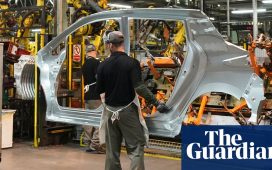The UK installed a record number of public electric car chargers in 2023 as the size of network of ultra-rapid chargers for longer journeys doubled.
Almost 16,000 public chargers were installed in the year to 12 December, pushing the total above 53,200, according to the data company ZapMap. That represented a 43% increase on 2022, significantly faster than the last three years.
Increasing the number of public chargers is one of the key challenges facing every country in the world in the switch from polluting petrol and diesel cars to electric vehicles.
The increase in UK chargers during 2023 has almost certainly outstripped the growth of electric car sales, which were up by 28% in the year to November compared with the previous 12 months.
Nevertheless, the number of chargers will need to continue its rapid rate of increase in the coming years, as rules known as the zero emissions vehicles (Zev) mandate force carmakers to sell rapidly increasing numbers of electric cars. The rules suggest 80% of UK car sales will be electric by 2030, despite Rishi Sunak’s decision in September to delay the ban on new petrol and diesel car sales from 2030 until 2035.
The continued rise in charger numbers will be vital to reduce “range anxiety” – the fear that drivers will not be able to find one to top up their battery.
Melanie Shufflebotham, the co-founder and chief operating officer of Zapmap, said growth in the number of faster chargers would help to reduce range anxiety. The number of the fastest “ultra-rapid” chargers doubled during 2023 to more than 4,600.
“There are now more than 10,000 rapid/ultra-rapid devices at 5,000 locations across the UK to support charging on longer journeys,” said Shufflebotham. “These can be found not just in motorway service areas or fuel forecourts but in many different types of locations, such as retail car parks and farm shops.”
Quick Guide
Electric vehicle charging speeds
Show

Not all chargers are created equal
More and more people are buying electric cars, and are having to grapple with charging for the first time. However, not all chargers are created equal, and the profusion of units can cause confusion.
Charging speeds are measured by power output in kilowatts (kW), while battery capacity is measured in kilowatt hours (kWh). For example, a Nissan Leaf has 39kWh of battery capacity, while a Tesla Model Y has 60kWh.
Recharge times vary depending on battery size: divide the battery size by the power to get a very rough idea of how many hours it will take to charge. (E.g., a 60kWh battery at a 22kW charger would take about three hours.) The quicker the charge, the more it tends to cost.
Slow: 3kW to 6kW
Common at homes, and on-street chargers. Suitable for charging overnight. Plugging in with a UK three-pin plug to the mains at home will deliver about 2.3kW – although it is not recommended.
Fast: 7kW to 22kW
Found at urban sites like supermarkets and shopping centres. Capable of charging a smaller battery in a few hours.
Rapid: 23kW to 100kW
Motorway service stations and dedicated public charging hubs. 50kW could give an 80% charge in less than an hour.
Ultra-rapid: 100kW and above
Some of the newest and most expensive cars can handle power up to 270kW, adding hundreds of miles of range in 10 minutes.
Andy Palmer, the chief executive of the EV charger provider Pod Point and a former boss of Aston Martin, said range anxiety was slowing the transition from petrol and diesel to electric, as it made some buyers hesitate before switching to a battery car.
However, Palmer, who also led the introduction of the Leaf electric car as Nissan’s No 2 executive, said the anxiety could be addressed by more chargers and that at 200 miles or greater, the ranges of cars being built today were big enough for most people.
“Practically, range anxiety is more of a perception problem, solved by a proliferation of public charging points, rather than an actual problem,” he said. “It’s important that charging infrastructure is able to counter that perception so that motorists can see the charging points in place and put their minds at ease.”
Palmer added that the key was ensuring people were “given peace of mind to carry out longer journeys”.
Ultra-rapid chargers are generally found near motorways and main roads to help people on longer journeys. However, the number of slow chargers being installed will also be crucial. Because of the lower power requirements, slow chargers are particularly attractive for people in towns and cities who do not have off-street parking to charge cheaply overnight.
Last year, the government under Boris Johnson announced a target of 300,000 publicly available chargers by 2030. If sustained, a 43% growth rate would easily hit that target, although in practice it would become steadily harder to install more as the best locations were taken. Companies hoping to install more of ultra-rapid chargers on main routes are also concerned that the rate of installation will diminish because of the slow pace of upgrades to the UK’s electricity grid.
There are also still large gaps in the charger network. Northern Ireland had only 23 chargers per 100,000 people in October, compared with 42 per 100,000 in north-west England, the next worst region.
London has 193 public chargers per 100,000, by far the best provision in the UK, although its need is also high because of the large number of car owners without off-street parking.









